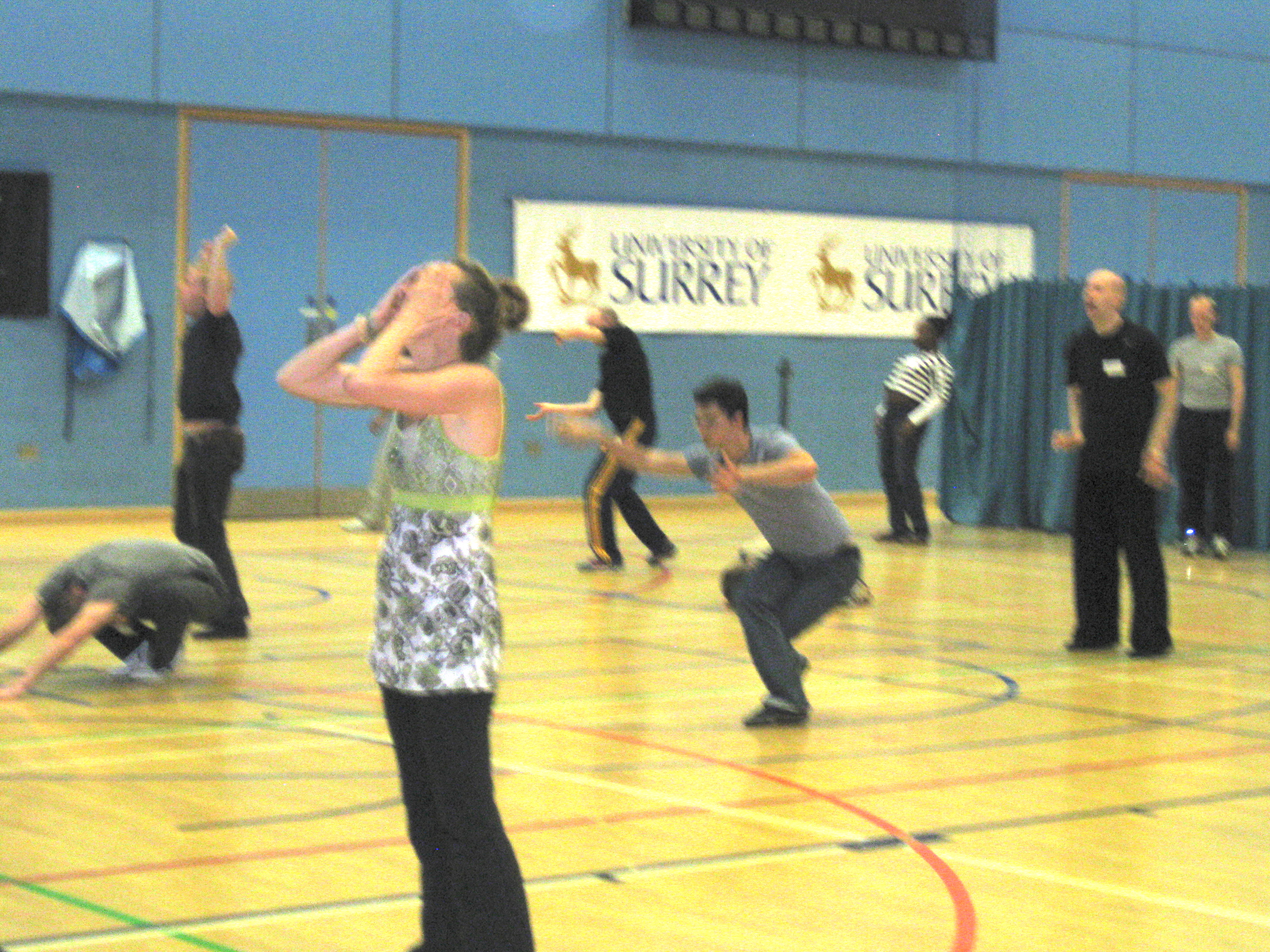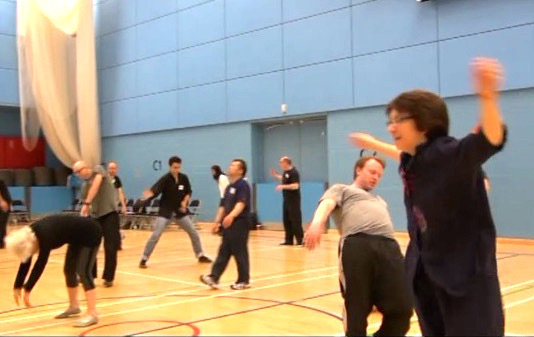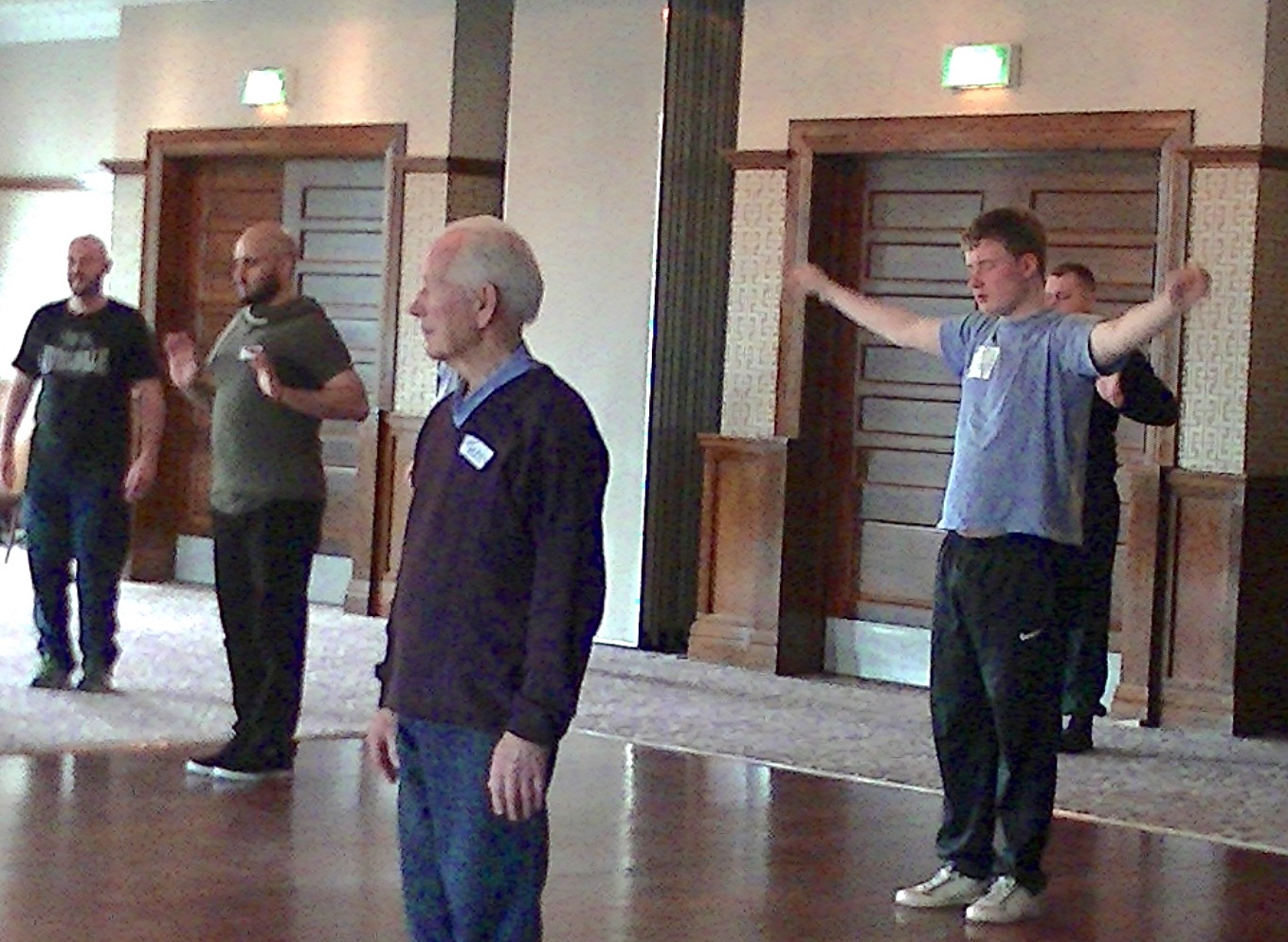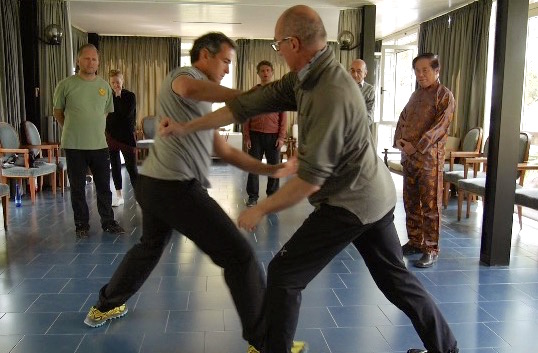SELECTION OF QUESTIONS AND ANSWERS
JUNE 2018 PART 1

Chi flow is spontaneous and harmonious, whereas deliberate movement is acted on and irregular
Question 1
How do we know it is chi flow and not that we move ourselves?
— Lee, Malaysia
Answer
Like many other things in chi kung and kungfu, such as internal force and a heightened level of consciousness, we know it is chi flow and not our deliberate movement from direct experience. Those who have no experience of chi flow will not know. Those who are still new to chi flow, may take some time to know.
There is a distinct difference between chi flow and deliberate movement. But it is difficult to describe this difference in words. Similarly, there is a difference between good pain, which results from people recovering from illness or injury, from bad pain, which is due to illness or injury, but it is difficult to explain the difference in words.
Chi flow is spontaneous and harmonious, whereas deliberate movement is acted on and irregular. Some chi flow is obvious, like hoping about like a kangaroo or rolling on the ground like a snake. No one, in his normal sense, would hop like a kangaroo or roll like a snake if not for his chi flow.
Question 2
Is it alright if we fall down during a chi flow?
Answer
It is alright if one falls down during a chi flow. It is not alright if he falls down when he is not in a chi flow, regardless of whether it is accidental or deliberate.
A practitioner is fully in control even in chi flow. If for some reason, he does not want to fall down, he can avoid the falling even when his chi pushes him to fall. However, to prevent accidents from happening, he must ensure his practice place is safe, like away from balconies and windows, and away from glass and drains.

Practitioners are in full control of their own movements when practicing chi kung
Question 3
What is the most important thing to do to recover fast in chi kung healing?
— Marina, Russia
Answer
If you want to recover fast in chi kung healing, just practice what you have been taught by your sifu without worries, without intellectualization, and enjoy your practice. Once a practitioner worries or intellectualizes, he (or she) goes out of a chi kung state of mind. A chi kung state of mind is an essential condition for practicing genuine chi kung.
The practitioner enjoys himself because by enjoying he can have many benefits. He is, for example, deep into his chi kung practice and finds his practice pleasant. All chi kung masters in the past asked practitioners to enjoy themselves and not worried about chi kung benefits. The benefits will inevitably come when they practice genuine chi kung.
However, we have become very effective in our chi kung practice. The benefits we get from our chi kung practice may be too powerful for us. We have to guard against going too deeply into a chi kung state of mind. For negative action, some practitioners may purposely intellectualize so as to be out of the chi kung state of mind.
It is worthy to know that healing takes time. If the healing is too fast, it may not be good for the person. His other organs work too fast for his diseased organs. Hence, you should take time to heal so that all your organs can work perfectly.
Our healing is much faster than what most other people experience. Don't make it too fast. Enjoy your practice, and don't worry, even if you later discover that you make some mistakes due to carelessness or forgetfulness, and don't intellectualize, unless you have over-trained and you want to slow down.
Question 4
Can we practice other arts when practicing Shaolin Wahnam chi kung?
— Kiefer, Germany
Answer
Of course, you can. You will do better in the other arts because of the skills you have gained in practicing Shaolin Wahnam chi kung.
You will, for example, know how to relax and be focused at the same time. You will also have more mental clarity and some internal force.

One will perform better in whatever he does if he practices chi kung from Shaolin Wahnam
Question 5
I mistakenly assumed that all proper chi kung involved entering silence.
— Olli, Finland
Answer
You are not mistaken. You are right that all proper chi kung and all internal arts involve entering silence. Not many people, including chi kung and internal art practitioners, know this fact. I did not know this fact during my students' days.
Because they do not know this fact, they think that if they practice the right techniques correctly for some time, they will derive the benefits of their practice. For us, it is not so.
The chi kung techniques practiced by chi kung practitioners are correct, but they do not derive the benefits of chi kung, like overcoming illness and attaining good health, vitality and longevity, because they do not enter silence during their practice. In our school, we call "entering silence" as "entering into a chi kung state of mind". But we must not enter silence too deeply; we have to guard against over-training.
If one does not enter silence, he does not perform chi kung or internal arts, although he may perform the techniques as an external form.
Indeed, more than 80% of chi kung practitioners all over the world make this mistake, and they are not aware of it. A good analogy is Taijiquan. Most Taiji practitioners do not practice Taijiquan, which is an internal martial art; they only practice Taiji external form.
Question 6
If I frequently and spontaneously enter into meditative states, could this lead to over-training? How can I modify my practice if I didn't want to reach deep states of meditation, but still wanted to get the usual benefits for my eyes?
Answer
To be in a chi kung state of mind, which is another way of saying in a meditative state, is both natural and healthy. To be too deep in a chi kung state of mind, or too deep in a meditative state, may lead to over-training.
Here are some ways to prevent or overcome over-training in the Eye Exercises or any exercises.
- Don't enter too deeply into a chi kung state of mind.
- Spend less time in training.
- Spend more time with your parents, out-doors, with friends, and in wholesome activities.
- Practice kungfu sets and combat sequences.
- Employ negative actions, like purposely tensing your muscles or intellectualizing. It is helpful to have a short, gentle chi flow at the end of your training session to clear away any harm due to the negative actions.

Our kungfu is not only beautiful to watch but also very effective for combat application
Question 7
We learn kungfu principles from the forms. In sparring we have to use Boxing?
— Tom, USA
Answer
You are entitled to your opponent, but what you say is not true.
Kungfu principles are often separated from kungfu forms. For example, the principle of "false false real real" is independent of kungfu form. In other words, you can use any suitable kungfu forms to implement this principle. The principle means that when you attack an opponent, your attack becomes "false" if he attempts to defend against it. You follow with a "real" attack.
Another important kungfu principle is "sound the east and attack the west". Again, the principle is independent of kungfu forms. You do not, for example, just kick at your opponent. You attack his upper body to distract him. When he responds to your top attack, you kick him below. You can use any suitable kungfu forms to distract him and to kick him.
Kungfu forms evolved from actual fighting. At first people fought randomly, like untrained people do today. Over many centuries, generations of masters stylized these random forms into kungfu patterns. These kungfu forms may or may not relate to any kungfu principles.
For example, you may punch out your right fist at a left bow-arrow stance, in a pattern called "Black Tiger Steals Heart" in Shaolin Kungfu, which happens to be a most popular form in many martial arts. You may use this kungfu form independently of kungfu principles. Or you may use it, often unconsciously, in conjunction of the kungfu principles of "continuous attack". For example, when your opponent attempts to defend against your attack, you grip his arm with a chin-na technique.
Using Boxing in sparring has many limitations. Many people forget that Boxing is a sport, not actually for fighting. One cannot, for example, grips a Boxer or attacks him at his back.
Those who use Boxing for sparring, do not know how to use kungfu for fighting. Those who know how to use kungfu for fighting would not use Boxing for sparring because of its various limitations.
It takes a much longer time to use kungfu for fighting than to use Boxing for sparring. Moreover, the methodology of using kungfu for fighting is generally lost today.
Question 8
The demonstrations in your webpages are beautiful to watch, but they are useless for fighting. Has your school taken part in any competitions to prove that your demonstrations can work?
Answer
The demonstrations in my webpages are not only beautiful to watch, they are also beautiful in their application. In fact they are meant for application, they are never meant to please spectators. If they happen to be beautiful to watch, it is a bonus.
If you do not know how to apply a certain kungfu form for fighting, it is simply because you do not know. It is certainly not because that kungfu form cannot be used for fighting.
Every kungfu form has at least one application, usually it has more. How would you respond, for example, when someone executes a punch at you? From your e-mail, you may bounce away, or parry it off like what a Boxer does. But there are countless kungfu forms you can use if you are trained to use them.
You may lean your arm against the coming punch using "Single Tiger Emerges from Cave". You may shift to a side and execute a kick at your opponent as his punch reaches its full extent, using the pattern "Happy Bird Hops up Tree". You may avoid his punch and move forward to fell him onto the ground using a kungfu form called "Fell Tree with Roots". You may grip his punching arm using the kungfu form "Old Eagle Catches Snake". But if you do not know and be trained in the combat application of these kungfu forms, you may bounce off or parry like a Boxer does.
They are many national and international champions in our school to show that our demonstrations can work in competitions.
But our Shaolin Wahnam members, including these champions, train kungfu to enrich their lives and the lives of others. Some of these champions won their titles before they joined our school. They were unhealthy due to their sparring and competitions, but after training in our school they demonstrate radiant health. Their combat efficiency also has improved tremendously.
LINKS
Selected Reading
- Chi Flow and Cash Flow
- Kungfu Forms for Fighting?
- Japanese Types of Meditation
- Wu Yu Xiang Style Taijiquan
- North to Chicago
